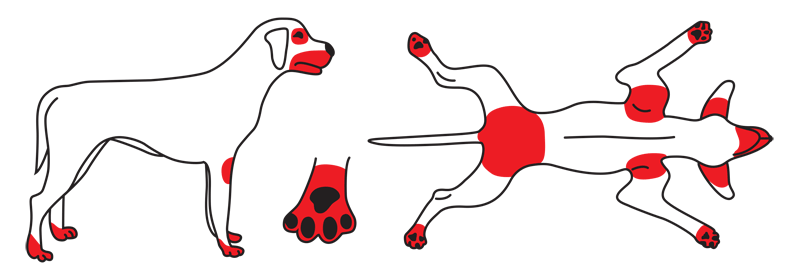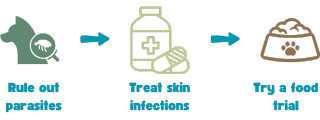Itchy ears, itchy arm pits, itchy paws, recurrent ear infections, hot spots. Sound familiar? It is possible that your dog has atopic dermatitis. This condition is similar to eczema in humans and is believed to affect some 10-15% of dogs. The condition occurs because the dog’s epidermis, or the outer layer of the skin is defective. Allergens in the environment, such as molds, pollens, dust mites, dander, and many others cause abnormal inflammation in these dogs that triggers itching. Some pets have a particular season that is worse, but others progress to a year-round struggle with the condition. These symptoms often start between 6 months to 3 years of age and affect the dog throughout its life.

Source: Review: Clinical and histological manifestations of canine atopic dermatitis. Bizikova, Petra, et al. 2, 2015, Veterinary Dermatology, Vol. 26, p. 79.
Atopic dogs often itch behind the elbows, lick their feet, scoot their bottoms on the floor, and may rub their faces. Over time the hair can become thin over the area, skin can become red, and they may develop open sores from self-inflicted damage. Light-haired dogs may have brown discoloration of the hair from constant saliva exposure while licking. Further progression can lead to thickened and very dark skin. Some dogs display rashes on the belly, behind the front legs in their arm pits, and/or at the base of the tail.
It can be quite frustrating to suss out exactly what is causing your dog to itch. Generally, we try to rule out parasitic causes, such as flea bite hypersensitivity or mange mites. Year round flea and tick preventatives are critical for these dogs. Many dogs with prolonged itching develop fungal or bacterial skin infections that need attention. We often diagnose this with a simple skin scrape that we can stain and view under a microscope. With severe or chronic wounds, a biopsy and/or a culture might be suggested. Food allergies can also contribute to constant itching, so a food trial is often necessary.

Food Trials for Cutaneous Adverse Food Reactions
There are a few food ingredients, largely animal proteins and some grains, that have been implicated in veterinary literature. In dogs, chicken, beef, dairy, and wheat account for some 75% of reported cases. Chicken egg, soy, corn, lamb, and fish are less common; issues with duck and rice are rare. Peanut and tree nut allergies are not reported in dogs. In cats, chicken, chicken egg, beef, dairy, fish make up 90% of reported cases.
The only way to diagnose a food sensitivity is to strictly feed a new diet for a minimum of 8 weeks. The dog will only receive the new diet during this time and all other treats should be eliminated. Sometimes, after completing the trial, we will try to add back the previous diet to see if itching and the previous ailments return. This would confirm that the diet is contributing to your pet’s allergic response.

There are three types of food trials.
- “Novel” Diet: This contains a protein source that your pet has never had, or has had infrequently. Examples include venison, pork, alligator, duck, rabbit, fish, kangaroo. These are usually paired with a less common carbohydrate source, like sweet potato, white potato, green pea, or an ancient grain. This is typically the first recommended diet to try.
- Hydrolysed Diet: The protein source in these diets has been partially digested by an enzyme to make much smaller molecules that are less inflammatory. Examples include hydrolysed soy, feather meal, chicken, and fish.
- Home-made diets: these diets can be effective, but require guidance to be sure the patient is getting the necessary micronutrients to meet their needs. We can help connect you with a nutritionist to be sure you are keeping your pet safe.
Allergen Immunotherapy
Additional allergy testing can be performed through a serious of skin injections or by looking at a blood sample from your pet. Often times, the offending allergens are so prevalent in the environment that its not possible to reduce your pet’s exposure. When your dog is allergic to a mold, tree or grass allergen, dust mites, or another allergen that is so prevalent – one strategy is start “allergy shots”, much like are done in humans. The laboratory creates a mix of the allergens that trouble your pet based on the allergy test, and provides this to you as an injection or oral solution that you can administer at home on a schedule.
Topical Therapy
- Include shampoos, sprays/rinses, mousse, and medicated wipes
- Help moisturize skin, treat bacterial and fungal components, and remove allergens from skin surface
- Some products include anti-histamines, corticosteroids, or topical anesthetic to help with pain and inflammation.
Oral Medications
- Target inflammatory component of the disease
- Corticosteroids (prednisone, prednisolone, methylprednisolone) are effective in providing relief during flare-ups, but have negative side effects associated with long term use. We aim to use the lowest effective dose for short duration and transition pets to a healthier long term option.
- Cyclosporine (marketed as Atopica) helps reduce itch and has fewer side effects than corticosteroids
- Oclacitinib (marketed as Apoquel) is a pill given twice daily initially, then once daily and is the preferred option for long term management. Apoquel has fewer side effects than corticosteroids. Apoquel inhibits a enzyme that interrupts the inflammatory pathway causing inflamed skin and works at neurons to stop the signal to the brain that causes the dog to want to scratch.
- Anti-histamines (cetirizine, hydroxyzine, diphenhydramine) are helpful for mild itching, but are not as helpful when pets are flared up and excessively itchy.
- Essential fatty acids are a component of healthy skin and may be used as a supplement to other therapies.
Injectable Therapy
Cytopoint (lokivetmab) is an injectable mono-clonal antibody that targets a specific inflammatory mediator that disrupts the process that leads to itching. This can be administered by the veterinarian every 4 to 8 weeks.
Allergies and atopic dermatitis can be a frustrating and expensive disease to manage. And worse, it can negatively affect a dog’s quality of life. Our goal is get the disease under control and prevent flare-ups. Luckily, there are options to address these issues using the different strategies discussed here. For some dogs, a consultation with a boarded veterinary dermatologist may be in order to dig deeper into the problem. Let’s get started! Give us a call to schedule an exam for that annoying itch and we’ll take the first steps towards relief.

 Phone: (828) 738-3883 | Fax: (828) 270-3213 Email:
Phone: (828) 738-3883 | Fax: (828) 270-3213 Email: